The name Hanna or Hannah has been used for eleven tropical cyclones and one extratropical cyclone worldwide.
The name Betty has been used for a total of seventeen tropical cyclones worldwide: one in the Atlantic Ocean, fourteen in the Western Pacific Ocean,, one in the Southwest Indian Ocean and one in the Southwestern Pacific Ocean.

The 2003 Pacific typhoon season was a slightly below average yearlong period of tropical cyclogenesis exhibiting the development of 45 tropical depressions, of which 21 became named storms; of those, 14 became typhoons. Though every month with the exception of February and March featured tropical activity, most storms developed from May through October. During the season, tropical cyclones affected the Philippines, Japan, China, the Korean Peninsula, Indochina, and various islands in the western Pacific.
The name Gorio has been used in the Philippines by PAGASA in the Western Pacific.
The name Agnes has been used for a total of sixteen tropical cyclones worldwide: one in the Atlantic Ocean, thirteen in the Western Pacific Ocean, one in the Southwest Indian Ocean, and one in the Southwestern Pacific Ocean.
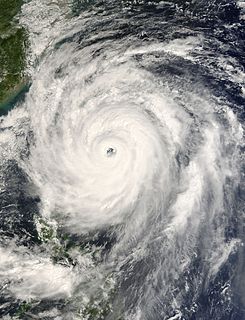
Typhoon Krosa, also known in the Philippines as Typhoon Ineng, was a powerful typhoon that impacted both China and Taiwan. The 18th tropical cyclone, the 15th named storm, and the 11th typhoon of the 2007 Pacific typhoon season, Krosa formed from a tropical system east of the Philippines in late September. The system became a depression on October 1, and on the following day, the depression quickly developed into a severe tropical storm. In the following days, Krosa rapidly intensified into a Category 4 super typhoon and reached peak intensity of 105 knots (194 km/h). Krosa would slowly weaken before making landfall on Taiwan. After making landfall on Taiwan, Krosa quickly weakened into a minimal typhoon, and rapidly weakened into a tropical depression between Zhejiang and Fujian provinces. Krosa transitioned into an extratropical cyclone on October 8. Extratropical remnants of Krosa dissipated on October 12.
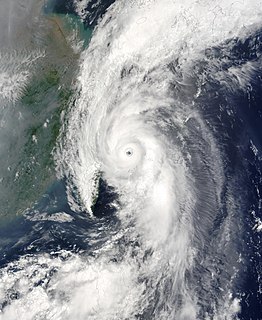
Typhoon Soudelor, known in the Philippines as Typhoon Egay, was a powerful typhoon that underwent rapid deepening east of Taiwan in the 2003 Pacific typhoon season. It was the sixth named storm by the Japan Meteorological Agency (JMA) of the season, as well as the third typhoon. It formed on June 12 from a disturbance in the monsoon trough, located east of the Philippines. The system moved generally to the northwest after its genesis, gradually intensifying into a tropical storm. While offshore the Philippines, Soudelor dropped heavy rainfall that caused flooding and left thousands homeless. The storm caused $2.46 million in damage, and 12 deaths.
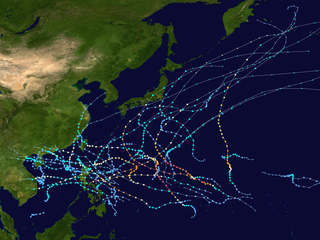
The 2009 Pacific typhoon season was a below average season that spawned only 22 named storms, 13 typhoons, and five super typhoons. It was also recognized as the deadliest season in the Philippines for decades. The first half of the season was very quiet whereas the second half of the season was extremely active. The season's first named storm, Kujira, developed on May 3 while the season's last named storm, Nida, dissipated on December 3.
The name Egay has been used in five tropical cyclones within the Philippines by the PAGASA in the Western Pacific.

Tropical Storm Soudelor, known in the Philippines as Tropical Depression Gorio, was a weak tropical cyclone that produced deadly flooding in the Philippines, China and Vietnam in July 2009. Forming out of an area of low pressure on July 9, Soudelor failed to maintain deep convection around its center for the duration of its existence. On July 10, the depression brushed the northern Philippines and intensified into a tropical storm on July 11. Later that day, the storm crossed the Leizhou Peninsula. The last public advisory from the JMA was issued the following day after Soudelor made landfall in southern China.

The 2015 Pacific typhoon season was a slightly above average season that produced 27 tropical storms, 18 typhoons, and nine super typhoons. The season ran throughout 2015, though most tropical cyclones typically develop between May and November. The season's first named storm, Mekkhala, developed on January 15, while the season's last named storm, Melor, dissipated on December 17. The season saw at least one named tropical system forming in each of every month, the first time since 1965. Similar to the previous season, this season saw a high number of super typhoons. Accumulated cyclone energy (ACE) during 2015 was extremely high, the second highest since the 1970, and the 2015 ACE has been attributed in part to anthropogenic warming.
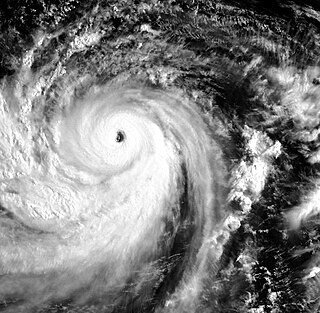
Typhoon Winnie, known in the Philippines as Typhoon Ibiang, was the worst tropical cyclone to impact the Chinese provinces of Zhejiang, Fujian, Jiangsu, and Shandong in 200 years. Originating from an area of low pressure over the Pacific Ocean on August 5, 1997, the system organized into a tropical depression. It headed northwestward, slowly strengthening into a tropical storm on August 9. Intensification became more rapid as conditions became more favorable, and Winnie reached typhoon strength on August 10. On August 12, 1997, Winnie attained Super Typhoon status, with peak 1-minute sustained winds of 160 mph. Winnie then weakened and passed north of Taiwan, before making landfall in Eastern China at Category 1-equivalent typhoon strength on the August 18. Winnie continued northeast over land while weakening, bringing heavy rainfall before dissipating on August 23.
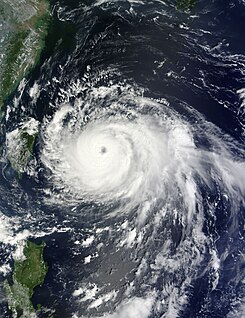
Typhoon Fanapi, known in the Philippines as Typhoon Inday, was a damaging and deadly typhoon that struck Taiwan and southeastern China in September 2010. It was the eleventh tropical storm and fourth typhoon of the annual season. The storm formed on September 14 east of the Philippines and moved slowly for several days, initially to the northwest, then curving to the northeast before turning westward due to a ridge to the north. During this time, Fanapi intensified to reach 10 minute maximum sustained winds of 175 km/h (110 mph). Fanapi made its first landfall on September 19 over Hualien, Taiwan, becoming the first typhoon to hit the island since Typhoon Morakot in August 2009. Later that day made a final landfall in Fujian, China. The storm dissipated on September 21 over southern China.

The 2020 Pacific typhoon season is an event in the annual cycle of tropical cyclone formation in which tropical cyclones form in the western Pacific Ocean. The season runs throughout the year, though most tropical cyclones typically develop between May and October. The season has been unusually inactive, with only 25 tropical cyclones, 17 named storms, and 7 typhoons forming since May 8. Additionally, the JTWC recorded no tropical cyclone development in the month of July, the first such occurrence since reliable records began. The season's first tropical cyclone developed on May 8, making it the sixth-latest start in the basin on record, slightly behind 1973, and the first to start this late since 2016. The 2020 Pacific typhoon season is less active than the 2020 Atlantic hurricane season so far, which has only happened twice before: in 2010 and 2005.

This timeline documents all of the events of the 2015 Pacific typhoon season. Most of the tropical cyclones formed between May and November. The scope of this article is limited to the Pacific Ocean, north of the equator between 100°E and the International Date Line. This area, called the Western Pacific basin, is the responsibility of the Japanese Meteorological Agency (JMA). They host and operate the Regional Specialized Meteorological Center (RSMC), located in Tokyo. The Japanese Meteorological Agency (JMA) is also responsible for assigning names to all tropical storms that are formed within the basin. However, any storm that enters or forms in the Philippine Area of Responsibility (PAR) will be named by the Philippine Atmospheric, Geophysical and Astronomical Services Administration (PAGASA) using a local name. Also of note - the Western Pacific basin is monitored by the United States' Joint Typhoon Warning Center (JTWC), which gives all Tropical depressions a number with a "W" suffix.

Typhoon Soudelor, known in the Philippines as Typhoon Hanna, was the third most intense tropical cyclone worldwide in 2015 after Hurricane Patricia and Cyclone Pam as well as the strongest tropical cyclone of the 2015 Pacific typhoon season. Soudelor had severe impacts in the Northern Mariana Islands, Taiwan, and eastern China, resulting in 40 confirmed fatalities. Lesser effects were felt in Japan, South Korea and the Philippines. The thirteenth named storm of the annual typhoon season, Soudelor formed as a tropical depression near Pohnpei on July 29. The system strengthened slowly at first before entering a period of rapid intensification on August 2. Soudelor made landfall on Saipan later that day, causing extensive damage. Owing to favorable environmental conditions, the typhoon further deepened and reached its peak intensity with ten-minute maximum sustained winds of 215 km/h (130 mph) and a central atmospheric pressure of 900 hPa on August 3. The Joint Typhoon Warning Center assessed one-minute sustained winds at 285 km/h (180 mph), making Soudelor a Category 5-equivalent super typhoon. Steady weakening ensued thereafter as the storm moved generally west-northwest. Soudelor made landfall over Hualien, Taiwan, late on August 7 and emerged over in the Taiwan Strait early the next day. The typhoon soon moved inland over eastern China and degraded to a tropical depression by August 9.
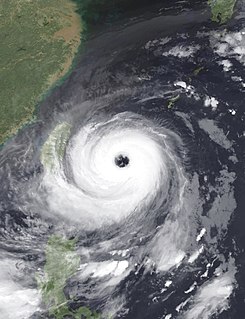
Typhoon Dujuan, known in the Philippines as Typhoon Jenny, was the second most intense tropical cyclone of the Northwest Pacific Ocean in 2015 in terms of ten-minute maximum sustained winds, tied with Noul. The twenty-first named storm and the thirteenth typhoon of the 2015 Pacific typhoon season, Dujuan brought extremely powerful winds throughout the Yaeyama Islands and Taiwan in late September, causing 3 deaths in Taiwan. The typhoon also caused over ¥2.5 billion (US$392.9 million) damage in East China.

Typhoon Meranti, known in the Philippines as Typhoon Ferdie, was one of the most intense tropical cyclones on record. Impacting the Batanes in the Philippines, Taiwan, as well as Fujian Province in September 2016, Meranti formed as a tropical depression on September 8 near the island of Guam. Tracking to the west northwest, Meranti gradually intensified until September 11, at which point it began a period of rapid intensification. Continuing to rapidly intensify, it became a super typhoon early on September 12, as it passed through the Luzon Strait, ultimately reaching its peak intensity on September 13 with 1-minute sustained winds of 315 km/h (195 mph). Shortly afterwards, it passed directly over the island of Itbayat. Meranti passed to the south of Taiwan as a super typhoon, and began weakening steadily as a result of land interaction. By September 15, it struck Fujian Province as a Category 2-equivalent typhoon, becoming the strongest typhoon on record to impact the province. Upon moving inland, rapid weakening ensued and Meranti became extratropical the next day, dissipating shortly afterwards after it passed to the south of the Korean Peninsula.

Typhoon Megi, known in the Philippines as Typhoon Helen, was a large and powerful tropical cyclone which affected Taiwan and eastern China in late September 2016. It is the seventeenth named storm and the seventh typhoon of the annual typhoon season.

Typhoon Saudel, known as Typhoon Pepito in the Philippines, is a currently weakening typhoon in the South China Sea. The seventeenth tropical storm and seventh typhoon of the 2020 Pacific typhoon season, Saudel formed from a tropical disturbance east of the Philippines. The disturbance gradually organized and crossed the Philippines as a tropical storm. Once the system emerged into the South China Sea, it began to rapidly organize and intensify, becoming a typhoon early on October 22.













